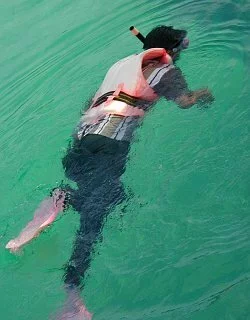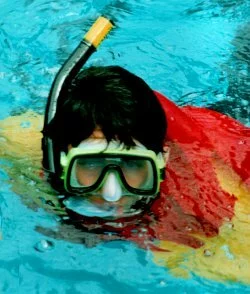|
|
Snorkeling - Just Float and Watch
Face down in the water and breathing through a short tube called a snorkel, your body is naturally buoyant. Even non-swimmers can do it safely using a flotation device. Sunburn: Cover Your BackThe most hazardous element to snorkelers is the sun. In adverts we see snorkelers in skimpy bathing suits, but in "reality" you better cover up for greater pleasure and protection. Even more than divers, snorkelers need full body protection to avoid jellyfish stings and the famous snorkeler's backside sunburn. Most eight-hour waterproof sun blocks last less than 30 minutes when snorkeling in the ocean. That is why sunburn becomes a major problem for adults, and especially for children who wear off sun block very quickly. Remember, your face may be submerged, but your back and parts of your legs are getting a full dose of ultraviolet rays. That warm tropical sun has far more burning power than most divers realise. Water and a light breeze can fool divers into baring more skin than they should. Too often, the result is a painful sunburn. Enjoy a Full Body SwimsuitRather that polluting the water with sun-creams, try using a Lycra jumpsuit with a 50+ UPF UV Protection factor. It also prevents Portuguese man-of-war, jellyfish, fire coral and other stinging hydroids from hurting you. You can wear it in the pool or the sea. Snorkeling is a great activity you can enjoy in these protective swimsuits. You don't have to worry about getting too much sun on your back, because it is made of special fabric that has high levels of UPF. You can take advantage of the scenery and not worry about getting sunburned or skin cancer. A Lycra snorkeling suit is so comfy you may want to wear it all day. Just take a shower after your swim to rinse the salt water or chlorine out of the suit. Then let it dry on you, weather permitting. Some suits have an integrated hood which covers your neck and ears, as those parts get burned most often. You can also get separate hoods that tuck into the collar of your swimsuit. |
|
|
|
Mask and SnorkelThe mask and snorkel are similar to those used in scuba diving, but since they are not subjected to the pressures of deep water, they can be more lightweight and comfortable. When selecting a mask, fit and comfort are important. You don't want a mask that leaks constantly because it doesn't fit your face. To try on the mask, move the strap out of the way, brush your hair out of the way, and just push the mask firmly onto your face. If it remains there unsupported, it makes a good seal. Once you have determined which masks will fit properly, other considerations are comfort and field of vision. Get a snorkel and maybe a spare strap to hold it to your mask. The snorkel mouthpiece should be soft with flexible edges to be comfortable in your mouth. FinsSwimfins aren't really necessary for snorkeling, but they do help you to get down more quickly so that you can see more of the underwater world on that breath of air. Your major concern here is comfort when selecting fins. Nothing will raise a blister faster than ill-fitting fins. Socks may reduce chafing. Scuba divers wear neoprene foam "booties" with their fins and this helps immensely. But because of the thickness of the booties, this may require a different foot size of fins. A larger fin area may allow you to swim somewhat faster but requires more "horsepower" to operate. Boat ExcursionsPlease keep to a minimum of clothes and gear, space is precious on the boat:
|
|
|
A hood protects your neck from sunburn when snorkeling.
|
Inexpensive Snorkeling Suit Alternative
Make sure you pick clothes that feel good and fit well both wet and dry. They should be soft and comfortable. Try them first in a pool or bath. Your hood should fit well and move with your head when you turn to the side. It must not obstruct your vision or slop around because it is too big. Keep it in place with the strap of your snorkel mask. Make sure the hood stays out of your mask's face seal, or it will leak. Jeans have the added benefit that they protect you from rough or sharp objects. The jeans pockets are useful to keep your keys, and maybe small objects you may find underwater. A jeans jacket over a thin pullover completes this outfit. Do not walk barefoot in shallow water near the reef. Sea urchin spines can cause painful puncture wounds to the bottom of your feet which can cause a nasty infection. Wear some tennis shoes, sandals, or fins. |


 You can simply wear light clothing in the water, like jeans and a long sleeve hooded pullover or anorak. This outfit is more practical as you can also wear it when you don't go swimming and you don't need to change clothes before you go snorkeling.
You can simply wear light clothing in the water, like jeans and a long sleeve hooded pullover or anorak. This outfit is more practical as you can also wear it when you don't go swimming and you don't need to change clothes before you go snorkeling.